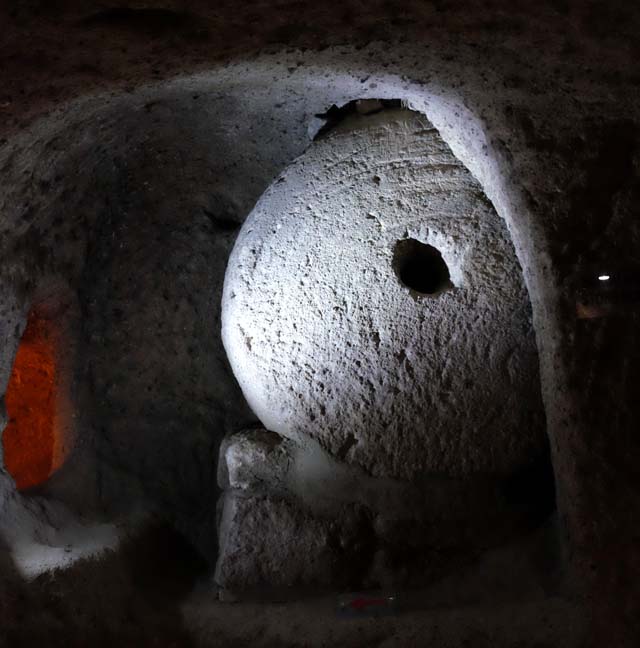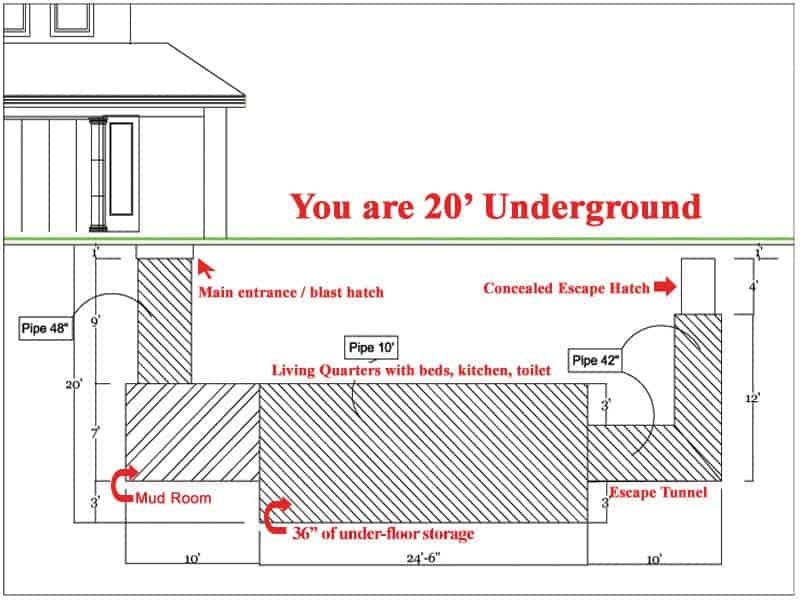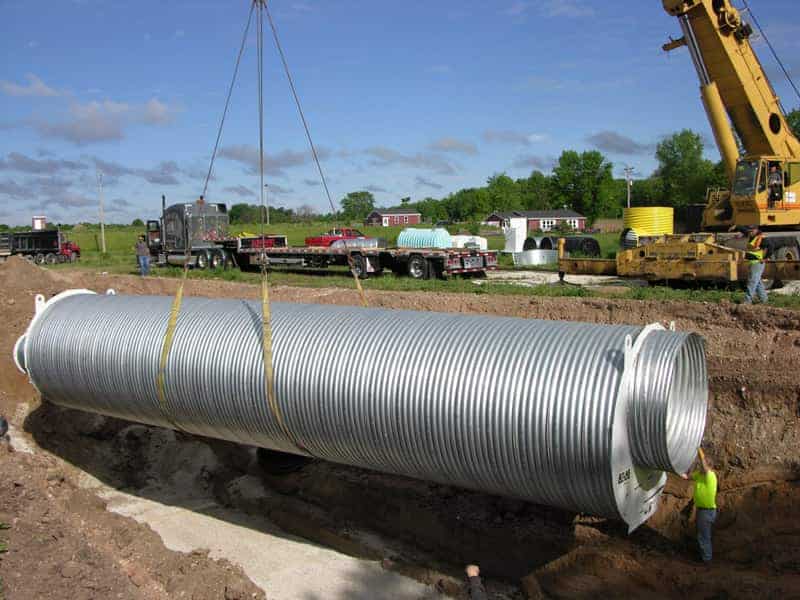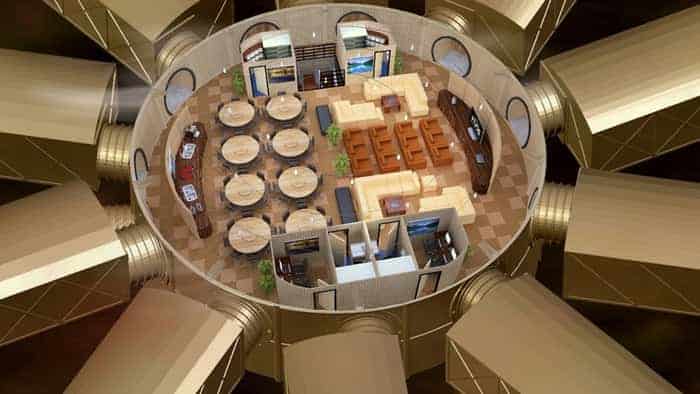There are a lot of ways to go about creating a hidden underground shelter. This post isn’t meant to tell you how to make your own shelter. That would be foolish because everyone has completely different needs when it comes to security.
Instead, I want to show you some examples of hidden underground shelters so you can get ideas for your own secure survival shelter.
Derinkuyu Underground City

Before we get into all of the cool modern underground shelters you can make, let’s take a lesson from history.
In 2000 and again in 2019, I traveled to Turkey and had the opportunity to visit one of the most amazing sites I’ve ever seen. Derinkuyu is an underground city that was probably built in the 15th to 12th century BCE to protect the locals from invading armies.
The underground city is impressive, to say the least. It could hold 20,000 people plus food stores and livestock. They had wells, a winery, a school, and chapels. There were air shafts to keep the people from suffocating underground.
As a prepper, you can learn a lot from the construction of Drinkuyu. One feature that fascinated me about this underground bunker was the massive stone doors. They are made from 1,000lb circular rocks. Thanks to grooves cut into the wall, the rock door could easily be rolled into passages from the inside but couldn’t be moved from the outside.


Find out how to build a survival shelter.
The people of Derinkuyu didn’t live underground all year. They also had homes above ground. They would retreat to their underground city if a raid were about to occur. The entrances were carefully hidden.
When the invaders arrived, they’d find an abandoned city above ground with no traces of where the people had gone.

Luxury Renovated Bomb Shelter in Georgia
This impressive renovated nuclear bunker is located at an undisclosed location in Georgia.
It is set on 20 acres and has features like 3-foot thick hardened concrete walls, which can withstand a 20-kiloton nuclear blast, a secure air intake system, HVAC underground systems, and much more.
Yes, this bunker will take you through doomsday in style!
You just need to have $17,500,000 to buy it.

Atlas Galvanized Steel Underground Shelters
Atlas is one of the most popular names in prefabricated underground survival shelters.
They offer many features, like models with a central entrance hatch plus escape hatch, tested air filtration systems, underfloor storage, and a 200-year lifespan. They also offer generator pods that can attach to the shelter underground for a concealed power source.
Prices start at $49,900.



Vivos Survival Shelters
Vivos is known for its massive underground survival shelters, which can house communities in the hundreds.
They use a spoke-like design, and multiple spokes can be put together to increase the size of the shelters.
The Quantum model is the best choice for individuals who want an underground bunker on their own land. They are 40′ long x 8′ wide x 8.5′ and can comfortably hold 6-8 people. One of the more notable features of the Vivos Quantum shelters is that they can be hooked up to an underground well. Then, using a hand pump, you can provide water for the tank. There is also a built-in NBC (nuclear, biological, and chemical) air filtration system and a diesel generator.
Don’t have your own land? You can apply to join in on one of their survival shelter communities. When doomsday hits, you can retreat to the shelter and wait out the disaster with a group of like-minded individuals and families.
These are luxury shelters, and you are expected to have a budget to match them!


Radius Engineering Survival Shelters
Radius Engineering Unlimited makes survival shelters with fiberglass shells; they won’t rust like steel shells and are less likely to crack than concrete shells. They have fantastic air purification systems which use 3 different purifiers. Radius builds its bunkers with nuclear warfare in mind, so the air purifier has a UV-radiation sterilization system, too.
These underground shelters are primarily meant for military and government use, but they do have family models too. The prices start at $200,000, and a multi-family pod will cost around $2 million. Note: the company has recently stopped selling to civilians – more information here


DIY Shipping Container Underground Shelter

Image: martiwf0 on YouTube
The cheapest way to get your hidden underground survival shelter is to make your own. Lately, there has been a lot of talk about using a shipping container as a bunker.
But using a shipping container for a survival shelter is almost always a TERRIBLE IDEA. Some of the main issues are:
- Corrosion
- Walls are not load-bearing – you must reinforce them!
- Need air shafts to prevent suffocation; these shafts could give away your location or get covered up and prevent airflow
- Not much storage space for food, water, and living
- Logistics – like how you will remove human waste
- No emergency exit hatch
On the other hand, a shipping container is a very easy survival shelter to install by yourself, and it is better than nothing. But, if you go this route, I’d recommend consulting with an engineer first to ensure you address all of the issues.
And, if you are already prepared to dig up your property and put a shipping container in it, you might as well spend a little bit more time and money to design your own hidden underground survival shelter.
Read our post about how to get your own survival shelter.
Are you thinking of installing an underground survival shelter? What route would you go with — prefabricated or DIY?
Let us know in the comments.



Radius Engineering Unlimited who makes survival shelters with fiberglass shells. Has no website. My internet searches yield no results. I comtacted a cyber security expert who was unable to find Radius Engineering Unlimited
Sheltering underground for a long time (i.e. more than a day or two!) seems so daunting to me that I might prefer to flee or die trying. No sunlight, promiscuity, no fresh food, no nature…and what world will you find when you finally come aboveground again?
Fiberglass is easy to work with. Try a small project first, like a fiberglass canoe, a teardrop trailer, or even just fiberglass somebodies old decaying wood deck to get used to the resin, sheeting, and tools (you can make an old deck look new again (and weatherproof it for about 30 years).
It is fantastic when you know what you’re doing, and underground you can use the cheaper polyester resin rather than the more expensive epoxy resin as used for yatches (It’s UV resistant, but expensive, cheaper polyester decays in sunlight after many years, unless it has a good gel coating).
Use plain old 4×4 posts in concrete for your strong supporting walls corners, then have 2×4 between them every 18″ vertical (and put 2×4 pieces between these posts staggered horizontal to keep it stable and strong under load. Then build your shape of shelter.
Top plate it with 2×6″ (top plates go along top of walls and the overlap should be inside the walls, not hanging over the outside).
Finally put 2×6 as joists on top of the top plate, lined up with the 2×4’s beneath the top plate for a strong roof, sheet the roof with something cheap, like chipboard (aka particle board), usually cheaper than plywood, then fiberglass resin over top of it to seal in the wood from rot.
Tack your fiberglass sheeting to the walls outside (use coarse fiberglass, it’s cheaper than the fine stuff used for car bodies, boats, etc, but is still very strong when resin coated), apply resin and let harden to your form.
Then drill, and cut out your entrance, ventilation ports, etc.
You should have a solid fiberglass encased load-bearing structure.
Let it air out for a week (depending on your climate) before you backfill or do much inside work. Resin is potent and takes a bit to harden and stop stinking, or filling your lungs with fumes. When inside (or working with resin, especially cutting/grinding) make sure you wear a good respirator. Not a useless mask, a respirator with filters. I know lots of guys who now have COPD likely due to their work with fiberglass and resins.
Maybe a look at what you will come out to.
Watch the old movie “ Blast From the Past” with Branden Fraser
so when the “all clear” sounds, what do you come out to and then what?
Have been working on planning an extensive reinforced concrete sustainable facility. Given planned walls of 18 inch and 24 inch heavily steel reinforced concrete, I am trying to determine the safe roof spans for each room…assuming I want it to withstand 45 psi blast overpressure and/or multiple earthquakes of 9 to 10. Where can I find such data?
Sorry, that is outside my scope of knowledge. Maybe ask at engineering universities for recommendations for someone who could help with that?
Have you thought about having to down size your home? We didn’t! But our old home has become more costly than we can afford. The concept of downsizing a home we have lived in for over 25 years and gradually stocked piled for the many “What If’s”, is daunting, to say the least. My step daughter just shook her head when my wife showed her our stash. The shed has been cleaned out. I must admit, the camping gear was donated to our Sharing House in town to help the homeless who live in the National Forest. A good cause! AND I hate to admit it, my step-daughter is getting the last laugh from our prepping. Bah-Humbug!
Interesting & Very Helpful, to someone like me who is not prepared. I am thinking for the future, of making an underground House (Used to be called Full Basements); and then having the house on top for everyday living. So this has been very helpful.
Nicole McCray,
About the cheapest underground shelter would be an earthbag shelter built in a deep enough hole to cover it with at least 2 to 3 feet (preferably 5 feet plus). Need stout branches covered with plastic for your roof.
Johnie
I do not have a stable income due to rural village life and can not seem to find a shelter i could afford to protect my 2 sons
We have a post here about building shelters without supplies which may be useful.
If you use established principles, the shipping container is viable… It needs to be surrounded by hollow concrete blocks on their sides… With a layer of polystyrene foam insulation between the container and the blocks. This prevents pressure building up on the sides of the container from “compacting” of the backfill. In very loose ground, it may be necessary to put more than one layer of concrete blocks around the steel.
Consider painting the steel of the container with bitumen based paint to resist corrosion.
The roof has to be strengthened. Make steel-reinforced concrete lintels twice the width of the shipping container. These should rest on the concrete block walls, and just clear the roof of the container after you have added some polystyrene sheets. The generous overhang of the concrete lintels, when the earth backfill is weighing down on them, evens out the downward forces on the lintel and makes the structure stiffer. The number of lintels depends on the depth below ground you intend to be…
Now some woven terylene sheeting… The kind they use to reinforce the ground in earth-fill dams. Cover the structure with this after filling in between the lintels with polystyrene sheets.
Now do your back-filling. Remember it’s going to be cold in there.
Thats a lot of extra work to make the structure viable, other options may make more sense in the long run. Thanks for the info though, definitely useful if you are going down the container route.
Interesting
That shipping container video looked like one of the worst ideas ever. The structure they showed being built had serious flaws that will collapse with a lot of concrete overhead. The flip side is the family burial site is also taken care of.
Would love to know more about underground sheltering,food storage ,waste removal ( bathroom) etc. Worried I’m not prepared for when shtf
Hi Yvette – we cover most of these things in various articles:
Try These:
https://www.primalsurvivor.net/bucket-toilet/
https://www.primalsurvivor.net/food-preservation-survivalists-guide/